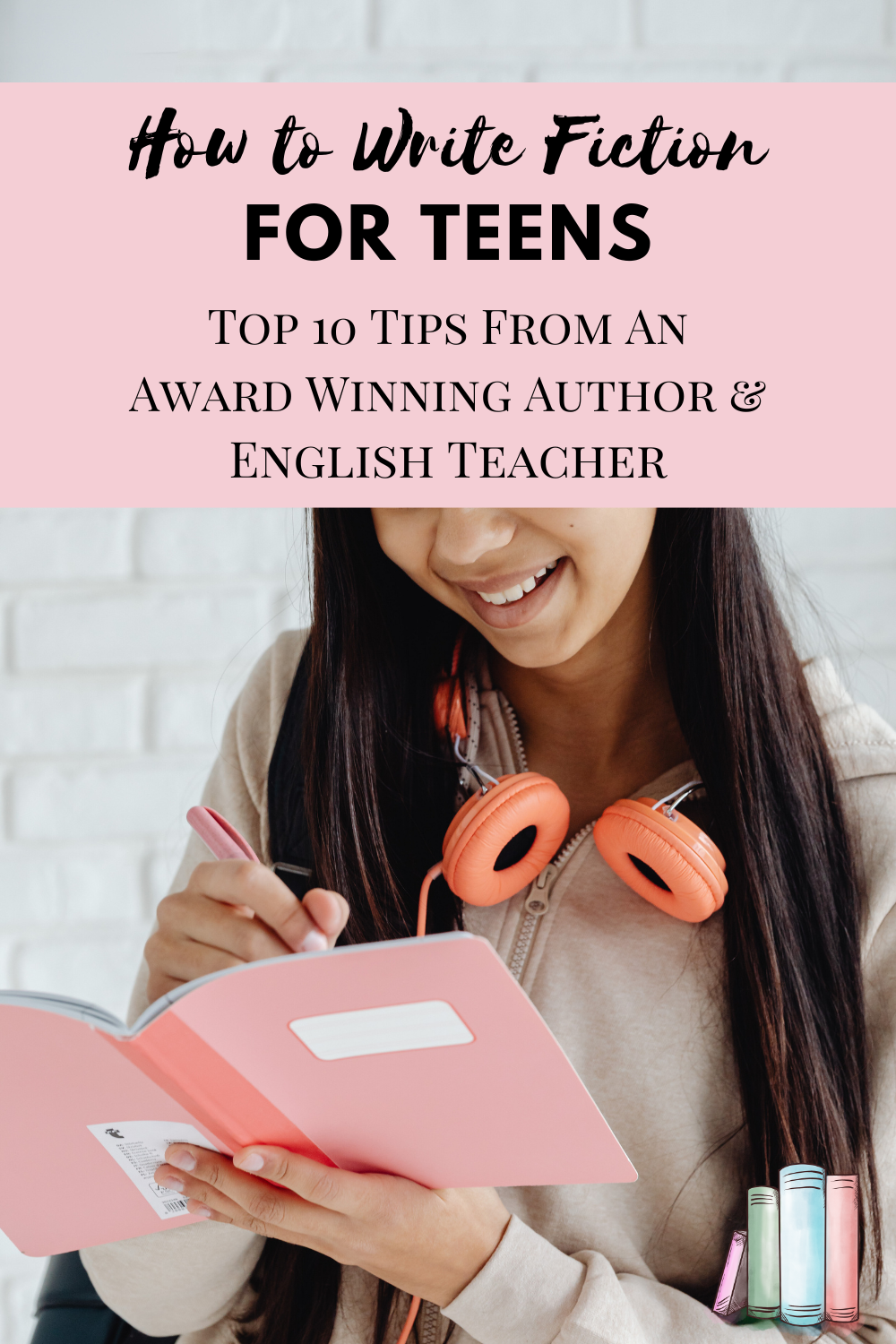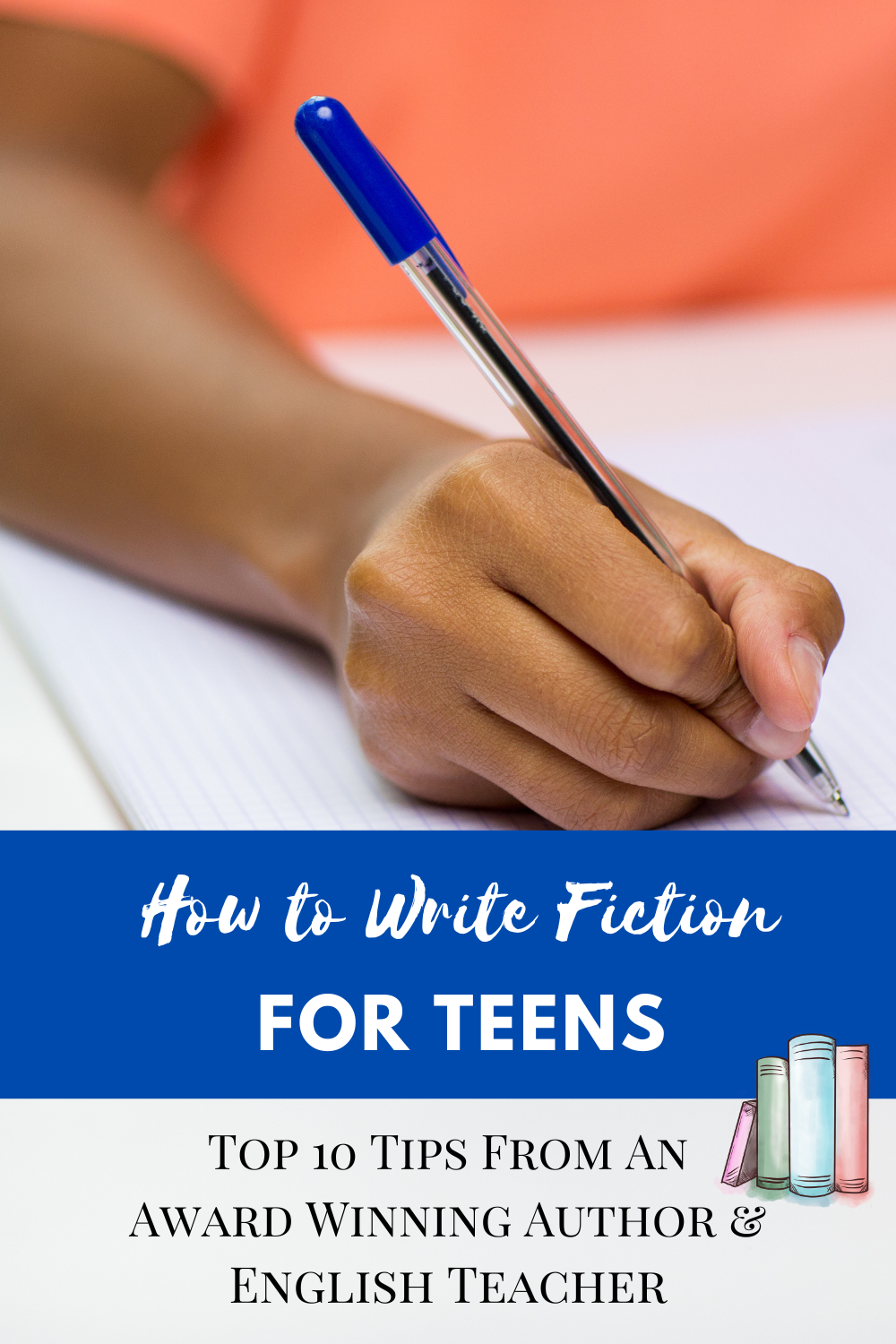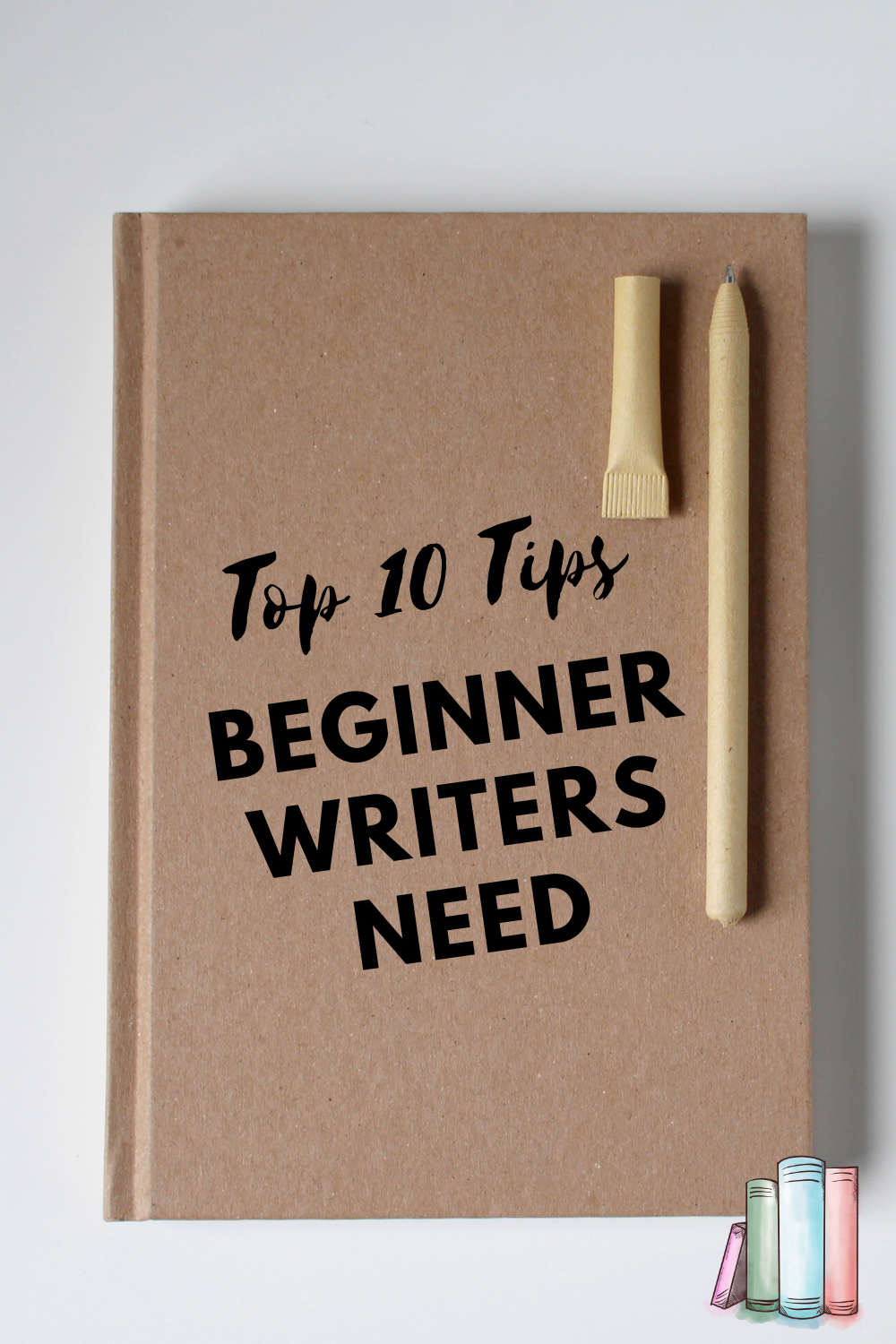The Secret to Writing Is To Write
Over my two decades of writing, I’ve gathered ten tips I would recommend to anyone of any age who wants to start writing, but isn’t quite sure where to start. So whether you are a teen, working with youth, or someone who has always wanted to learn how to start writing fiction, then this list is for you! Grab a pencil a pen, an iPad, or save this to Pinterest, and let’s dive in!

Top 10 Tips for How To Write Fiction
"Do not fear the blank spaces. They are yours to fill."
S. Faxon Tweet X
10. Find a Genre or Style of Storytelling You Love
Before you start writing, think about genres or styles of storytelling that appeal to you. You are the one who will be writing your story, so familiarize yourself with the genre that you gravitate towards.
For example, I write dark fantasy and horror because these are the stories that I love consuming. My “Suggested for You” sections on my streaming apps are full of things like true crime stories, Witcher, Lord of the Rings, Stranger Things, Pirates of the Caribbean, Babadook, Damsel, and so on.
I watch and read these types of stories because I love them. The character arcs are familiar and the deeply imaginative plots help me to dive into the mindset I need to create my own fantasy or horror-filled worlds.
Start scrolling through your Netflix, Prime, or HBO recommendations – is there a common theme between them? A common type of genre that starts to emerge? Is it a list of romances or action titles? Is Liam Neeson, Jamie Foxx, or Sigourney Weaver’s face plastered all over your movie list? What kind of movies do those favorite actors of yours star in? You can use these ideas as a starting point to see what direction you will want to write in.
I also recommend trying to picture your favorite actors as your characters. This might seem silly or strange at first, but sometimes having a familiar face for the people who will “play” the characters in your mind is another good way to start!
9. Read and Do Your Research
We cannot talk about writing basics without talking about reading. Once you have an idea of what genres you would like, READ those genres. Get to know them. The stereotypes, the expectations, the rules, the worlds, the expectations of comedy, the expectations of tragedy, learn about your genres by reading the books from your genre.
As a dark fantasy and horror author, I have a TON of books under my proverbial sleeve that I have read over the years within my genre. Some classics, like Mary Wollstonecraft Shelly’s The Modern Prometheus (Frankenstein), some recent, like Jay Kristof’s Empire of the Vampire, some lighter, like Brielle D. Porter’s Jester, and some quite short like anthology collections written by various authors like my most recent read, Never Whistle at Night edited by Shane Hawk and Theodore C. Van Alst Jr.
If you’re not sure where to start reading, I recommend checking out an anthology. These are great ways to get to “meet” new authors and to expose yourself to a variety of writing styles within a particular genre or theme.
Something I am adamant about is that there is ALWAYS time to read. Even if you just niche out 5 minutes a day, you can do it. Set a reminder in your phone, carry your books with you in your digital library (Kindle, Apple Books, Bookstore), there are a myriad of ways to have literature available to you any time throughout the day. So do your soul a favor and schedule in time to read today!
I read either in the morning before I’m getting ready to go to work, when I come home from work, or before I go to sleep, it all just depends on the day. Personally, I don’t like to read before I go to sleep as I feel like I’m training my brain to want to sleep after reading, but do what works for you! Set a timer of 5 minutes at first, then 10, then 15, then 20. You’ll be amazed at how quickly that time flies by and how far you can get in a story in so short an amount of time!
“If you don't have time to read, you don't have the time (or the tools) to write. Simple as that.”
Stephen king Tweet X
Reading allows us to research our genres, but it also allows us to acquaint ourselves with topics or ideas that we want to write about, but don’t know enough about.
For example, in my series The Blue Dragon Society opium is a major “dragon” many of the characters have to face, but I knew next to nothing about the subject of opiates prior to my research. I learned so much about the trade within the 1800s, which was specifically the time frame I needed for the setting of my story. While researching opiates in 2024 is interesting, it doesn’t apply to the situations my characters will face, aside from the addictive elements, so when you are doing your research, try to monitor yourself so you don’t get lost in the weeds of trying to learn everything.
As you research, check in with yourself to see what you will need to make sure your story makes sense, to ensure you are being sensitive to subjects that may require a sensitivity reader, (someone who is familiar or has expertise with a topic that you may not be), and to ensure you are not packing in extra details that don’t contribute to the overall arc or flow of the tale.
8. Find and Follow Your Favorite Authors
Once you’ve established a few authors that you really enjoy, start following them (not literally) on social media, visit their websites, and learn about their writing process or their journey, the research they have done, or the books they enjoy. In doing this, you’re not copying them, you’re building a house of your own off of their foundation.
The authors I’m currently following are Margaret Atwood, Roxane Gay, N.K. Jemisin, and Alex North to learn about their writing process, the research they perform, and how they bring their stories to life. I have read and attended countless writing craft books, blogs, and events, and can happily say that learning from fellow authors has proved to have some of the most beneficial and lasting boons to my craft. So start looking your favorites up and see what they’re doing to keep themselves writing!
7. World Building
Speaking of practices I have learned from other authors…
I watched the Master Class on N.K. Jemisin, a wonderful science fiction and fantasy author, discuss her writing process and one of the biggest lessons I have used and shared with others is, starting with the world where your story takes place. Even if it’s your neighborhood on any other day, build the structure of what is possible in your world and what is impossible in your world. Sit down, or stand, and make a list of what can happen in your world and what can’t.
When I’m teaching a Creative Writing unit, which is available for educators at a discount in my Teachers Pay Teachers store, I ask my students to write on the back of the page everything they can think of that is able to happen within the world they are creating and what can’t, so they can start building challenges their characters will face in their world. If people aren’t able to breathe underwater, how might that cause a wrinkle in their plot?
If people are able to fly, how will that contribute to their plot? What happens to the one person who can’t fly? Are they they main character? Or are they the antagonist? By building the framework in line with the genre expectations, we can begin to see the stems of our story grow.
6. Plotting or Pantsing?
In literature, pantsing is not when we pull down the pants of someone unexpectedly. Pantsing is when we write by the seat of our pants, following the stars our characters direct us, in the moment.
I attended an event where Christina Henry, author of Alice, told her audience about how this is her method of writing and that it works brilliantly for her. She sits down for around four hours almost every day, goes on runs, and writes in the moment. For some authors, this is a method they swear by.
I love lists and need to know where I’m going, so I’m more of a plotter.
Plotting is when an author writes an outline of what they want to happen in their story.
For some authors, this is a general outline they are flexible with, just something to help lead the way as they write. For other authors, it’s a strict set of rules they must follow to the end, no matter the consequences or what their characters are screaming.
Neither panting or plotting is “better” than the other, and I recommend trying both and seeing which one or combination of the pair work for you!
There’s a wide variety of ways you can plot your story. I recommend starting with your genre first to see if something like Joseph Campbell’s Hero’s Journey or a three-act structure, or if Freytag’s pyramid might be a good fit for the story you are trying to develop.
For my high school students, I ask them to start with Freytag’s pyramid as this style is a nice fit for short stories. It’s a clean and simple path with the following steps:
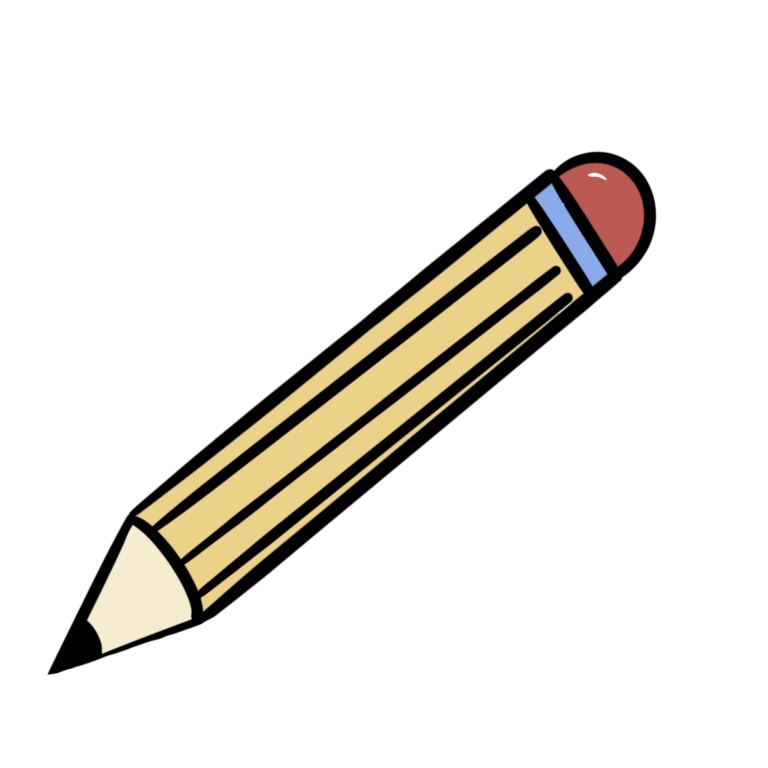
- An exposition – introduction where we get to see what “normal” is like for your character
- Introduction of conflict – something happens to your character that rips them out from their “normal”
- Rising conflict – where we see the tension building as the character progresses through the story to eventually confront their conflict
- Climax – where they character has to meet their worst fear, greatest enemy, decide if they kiss the girl or not.
- Falling Action – the immediate consequences of the confrontation
- Resolution – where the character ends – I always say that while your character may literally go home again, they have to have grown some way some how throughout the story, so it’s nice to see who they are as a result of the trials they endured along the way.
- While Freytag is a nice place to start, there’s also Fiction curves, which are a nice way to see our characters win some and lose some, getting closer and close to the climax along the way, which has a very realistic flow to it.
There are also tragedy plot lines, save the cat, comedy, romantic comedy, horror, westerns, and many, many more.
Take an afternoon to go through a bunch on Google and see which feel right for you and for your story. Try to not squeeze your story into one of these – pick and choose elements from the ones that fit to your story.
5. Character Development
Now that you know what happens, who the heck is it happening to?
Character development is one of the richest activities of developing a story.
I have ugly cried over things I have done to some of my characters because they are so real to me and have occupied many hours of time within my mind and heart that they are like family.
When you’re building your characters, it’s important to distinguish what you know about your characters versus what your readers need to know about your characters.
Ask yourself, who is my character? But go deeper than they like Disney movies and shop at Aeropostale. What do the details tell us about them as human beings and how do these details move your plot forward?
If the brands they wear or don’t wear matter to the story, include those details! Ask yourself, is this a detail I need to include to further the plot and the character’s role in it?
For example, in my urban fantasy novel Blood Lords, my character Liam Hamill wears an analog watch even though his co-workers gave him an i-Watch for his twenty-fifth work anniversary. This might seem like a small detail, but I’ve included it to demonstrate that Liam is more comfortable with something familiar than something high-tech; he believes a watch has one job and that it is to tell the time. He doesn’t have the time to figure out how to use his i-Watch, so he doesn’t see the point in wearing it. We learn from this that he is busy and with 25 years as an SDPD detective, it suggests that all of his time goes toward his job, which is an integral note about this character, but I’ll stop there as this is a mostly no spoiler zone.
When you’re describing your character, be cautious with the “they look at themselves in the mirror” descriptions – this is overdone and while I have woven in some details that way, try to get creative with how you reveal who your character is through their interactions with other characters, animals, and the setting. Setting can be an incredible tool to tell your readers about your characters; is your protagonist sitting alone in a cubicle late at night, with mountains of files piled up on either side of her computer? Are there blood stains in your antagonist’s golden hair? Weaving in these types of details can build tension and intrigue about your characters, which will ultimately serve your story better than something like: She stood there, staring into the mirror, her narrow shoulders inclined slightly to the left with her radiant red curls cascading like a waterfall over her ears and down her neck.
Blech. I cringed writing that.
4. Where to Start Your First Draft
I recommend getting a good ol’ composition book and a pen or pencil that feels good in your hand. Label and date the top of your pages so you know what you were working on and when. Carry this notebook with you everywhere as you never know when or where inspiration might strike!
While I primarily use the writing program Scrivener these days to develop my stories as it keeps all of my notes, inspirational images, and writings nice and organized, I still carry around a composition notebook. My current story notebook is actively at the side of my bed, never too far out of reach.
But if neither of those options sound good to you, try Google Docs, One Note (which is an excellent way to keep your details organized), GoodNotes – another favorite of mine, which I use on my iPad with my handy Apple Pencil daily, Word, Pages, the little note app on your phone – make it something you want to open. If it’s a pad and pencil, find the pencil that feels like a wand in your hands ready to whisk you and your characters away.
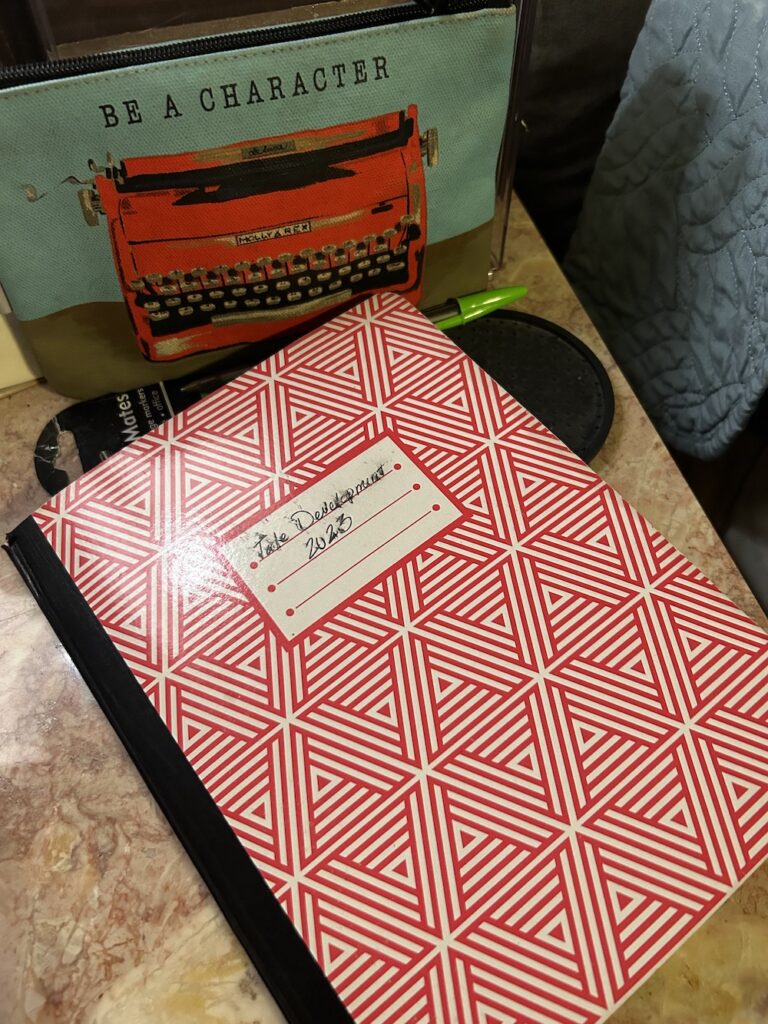
3. Building Confidence in Yourself
But what if you still don’t know what to write and don’t feel like you’ll ever be able to finish a story?
Stop right there.
YOU ARE A WRITER. The fact that you’re this far along in a 3,000+ word article tells me so. You have the desire, you’re trying things out, you’re putting words on a page, which makes you a writer. It took me years to find that confidence within myself to call myself a writer and to take a seat at the table. I had imposter syndrome for ages but now I know that the power of writer is a part of me, as I’m certain it is also a part of you, and there’s no shame in needing training.
On my desk, I have some reminders to keep my head held high – one is such a silly little thing, but it was a card a friend gave me that says, “Sarah, congrats on your 1st book signing! Cheers to many more.” A quick glance at that note reminds me that someone believes in me and that I am a writer.
In your writing space, build these reminders for yourself. Whether it’s a sticker on your notebook, a Funko Pop on your desk of your favorite character, or a candle lighting ritual, make the space where you write comfortable and cozy, so you’ll be able to confidently fill up those white pages. Like James Clear says in Atomic Habits, make it attractive so you’ll want to be there. Make it attractive for yourself, so you believe you can.
2. Make Time to Write
But when do I write?
Just like with reading, you have to make time for it. I write almost every day, not quite every day, but it actually feels like my soul hurts when I don’t have the chance to sit down and dabble out a few thoughts. Even if the words are complete garbage (usually they’re not) I write. This is another reason why I like using Scrivener; I have it on dark mode so the screen is easier on my eyes, I have it at full screen and on type-writer mode, so where I’m typing is always at the center of the screen. This helps me to find my transcendent flow state, even when my husband is downstairs hollering at a sporting event, I’m able to stay focused and to hit my daily word count.
Ok, but when do you write?
I write for about 45 minutes to an hour before I sleep. This is how I wind down, which is probably not the healthiest thing as I’m staring at a screen, but my glasses have a blue light filter, which is something I also highly recommend having within your toolkit.
Some methods of writing that I’ve used and found helpful are setting a timer following the old Pomodoro method. Play with this and see what works for you – start with ten, then fifteen, then twenty minutes. I have a Time Writer exercise I do with my students to help them hone in and focus on what’s in front of them.
When you’re using time to help keep you focused, I recommend that you don’t worry about the details, the grammar, spelling, mechanics, or even the words at times. Just stare at the story and see where it takes you. There’ll be times when I’m in the zone and I can’t think of a words, so I’ll write something like BLAHHAHAHA so I can easily find it again when I’m editing later.
First drafts are messy. They’re supposed to be. There is no perfect first draft, so don’t worry about editing or rereading until later.
One of my favorite quotes of all time is from the movie Finding Forrester which is a little dated now, but it stared Sean Connery and Rob Brown. The quote is from the character Forrester who is mentoring a young writer and he says, “No thinking – that comes later. You must write your first draft with your heart. You rewrite with your head. The first key to writing is to write, not to think.” Spoken like a true pantser, haha.
And even though I’ve spent the last 3,000 words describing how to plot and plan, writing from the heart is the BEST takeaway from this entire article and the best advice I follow and give.
Here’s the clip with the quote from Finding Forrester if you want to check it out:
1. Never Give Up!
THIS is the most important step.
Believe in yourself, believe in your craft, believe in the hard work you have done and will continue to do as a writer. Anything is possible with focus and effort, which you are absolutely capable of. You made it to the end of this article, which was no small feat, so give yourself a pat on the back, reward yourself, then sit down and write.
I dive deeper into many of the topics above within the book I co-wrote with Theresa Halvorsen, How to be a Successful Author and Not Lose Your Mind, if you’d like to learn more about the next steps of the writing journey, the marketing and publishing side of things. If you would like worksheets to lead you or your students along the process, check out this creative unit bundle in my store: here is the link to the discounted unit for teachers and here is the one if you do not have a Teachers Pay Teachers account. These activities are currently targeted to teen writers, but they have everything a young writer needs to get started, except for a pencil or pen.
If you found any of these tips helpful, please let me know in the comments below! I LOVE helping other writers so if you have any questions, please feel free to write to me at author@sfaxon.com.
Happy writing!
-Sarah

Save this post to your Pinterest!
